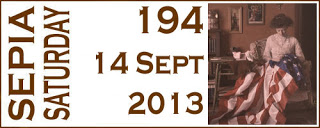There used to be a town called Mologa. It developed to serve the land selectors that started arriving in the 1870s. Now the shops, churches, school and post office have almost gone. But the War Memorial remains and it records the names of sons of those selectors who served in two world wars.
The two photos below have been taken from almost the same position and you can see in the first some of the buildings that used to be there in the 1920s. Great-uncle Ray Leed was killed in France and Great-uncle George Leed served in France. Both are named on the memorial. In fact for such a small community there are a lot of names on the memorial and this is repeated all over Australia.
 |
| Mologa war memorial (Alford family album) |
Most towns and cities in Australia erected memorials after the first world war and they still hold an important place in our culture. They are the focus point for the ceremonies that are held each year to celebrate the volunteers who left to serve overseas. And the communities also planted memorial avenues of trees, installed memorial boards in halls, clubs and workplaces and built memorial halls, bridges and so on. The war had a huge impact on the peace time that followed.
Not far away from Mologa is the town of Mitiamo. At the time of the first world war it was bigger and busier than it is now but it hasn't disappeared like Mologa has, and the community at Mitiamo also installed a memorial. I remember reading somewhere that this memorial is unusual in that it has a female sculpted figure - presumably she represents something or other and is not just there to look pretty. She seems to be holding a basket of fruit or vegetables.
Grandpa Roy Phelan (at right in the photo below) served in France in WW1 and his name is on the memorial. And so are the names of his two sons, Neil and Keith, who served in WW2.
 |
| Mitiamo war memorial (Phelan family album) |
 |
| Mitiamo war memorial (Phelan family album) |
The photo above is interesting because it records the German machine gun that was also installed at the memorial. It is no longer there and I believe it was stolen.
The theme for this week's
Sepia Saturday was peace, as in a campaign for peace, but I don't have any campaigners in my photo collection. So I went for the 'peace after war' idea. I suggest you march on over to see what other Sepians have to say about peace.



















.JPG)




















